Jason Weston
RESTRAIN: From Spurious Votes to Signals -- Self-Driven RL with Self-Penalization
Oct 02, 2025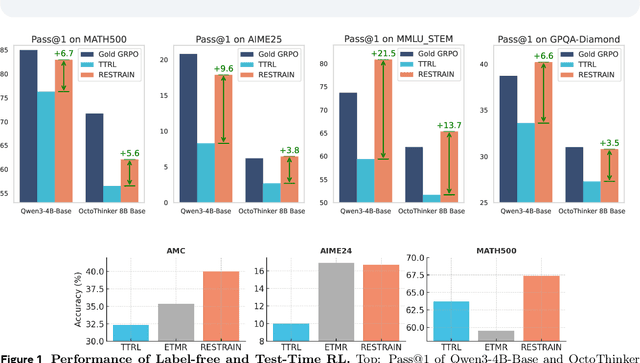
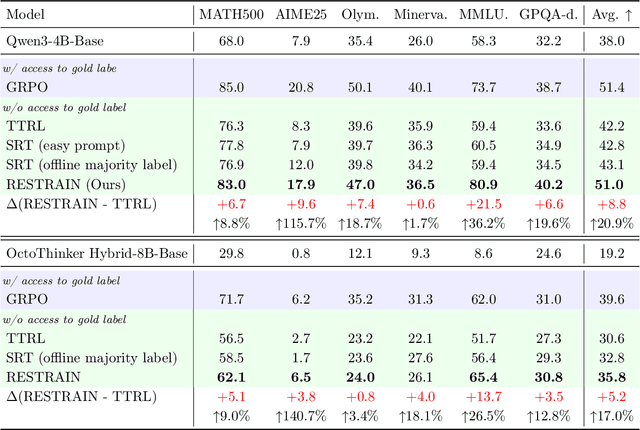

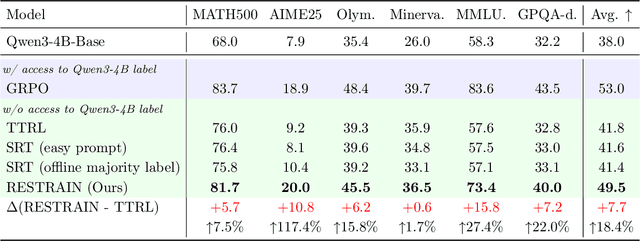
Abstract:Reinforcement learning with human-annotated data has boosted chain-of-thought reasoning in large reasoning models, but these gains come at high costs in labeled data while faltering on harder tasks. A natural next step is experience-driven learning, where models improve without curated labels by adapting to unlabeled data. We introduce RESTRAIN (REinforcement learning with Self-restraint), a self-penalizing RL framework that converts the absence of gold labels into a useful learning signal. Instead of overcommitting to spurious majority votes, RESTRAIN exploits signals from the model's entire answer distribution: penalizing overconfident rollouts and low-consistency examples while preserving promising reasoning chains. The self-penalization mechanism integrates seamlessly into policy optimization methods such as GRPO, enabling continual self-improvement without supervision. On challenging reasoning benchmarks, RESTRAIN delivers large gains using only unlabeled data. With Qwen3-4B-Base and OctoThinker Hybrid-8B-Base, it improves Pass@1 by up to +140.7 percent on AIME25, +36.2 percent on MMLU_STEM, and +19.6 percent on GPQA-Diamond, nearly matching gold-label training while using no gold labels. These results demonstrate that RESTRAIN establishes a scalable path toward stronger reasoning without gold labels.
Stochastic activations
Sep 26, 2025Abstract:We introduce stochastic activations. This novel strategy randomly selects between several non-linear functions in the feed-forward layer of a large language model. In particular, we choose between SILU or RELU depending on a Bernoulli draw. This strategy circumvents the optimization problem associated with RELU, namely, the constant shape for negative inputs that prevents the gradient flow. We leverage this strategy in two ways: (1) We use stochastic activations during pre-training and fine-tune the model with RELU, which is used at inference time to provide sparse latent vectors. This reduces the inference FLOPs and translates into a significant speedup in the CPU. Interestingly, this leads to much better results than training from scratch with the RELU activation function. (2) We evaluate stochastic activations for generation. This strategy performs reasonably well: it is only slightly inferior to the best deterministic non-linearity, namely SILU combined with temperature scaling. This offers an alternative to existing strategies by providing a controlled way to increase the diversity of the generated text.
StepWiser: Stepwise Generative Judges for Wiser Reasoning
Aug 27, 2025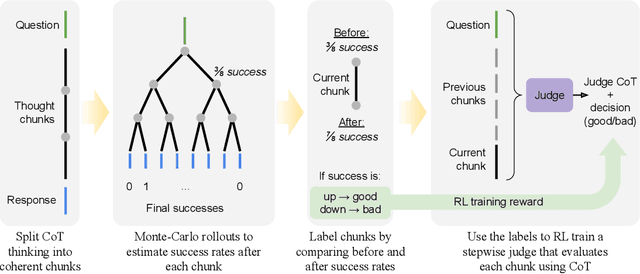



Abstract:As models increasingly leverage multi-step reasoning strategies to solve complex problems, supervising the logical validity of these intermediate steps has become a critical research challenge. Process reward models address this by providing step-by-step feedback, but current approaches have two major drawbacks: they typically function as classifiers without providing explanations, and their reliance on supervised fine-tuning with static datasets limits generalization. Inspired by recent advances, we reframe stepwise reward modeling from a classification task to a reasoning task itself. We thus propose a generative judge that reasons about the policy model's reasoning steps (i.e., meta-reasons), outputting thinking tokens before delivering a final verdict. Our model, StepWiser, is trained by reinforcement learning using relative outcomes of rollouts. We show it provides (i) better judgment accuracy on intermediate steps than existing methods; (ii) can be used to improve the policy model at training time; and (iii) improves inference-time search.
OptimalThinkingBench: Evaluating Over and Underthinking in LLMs
Aug 18, 2025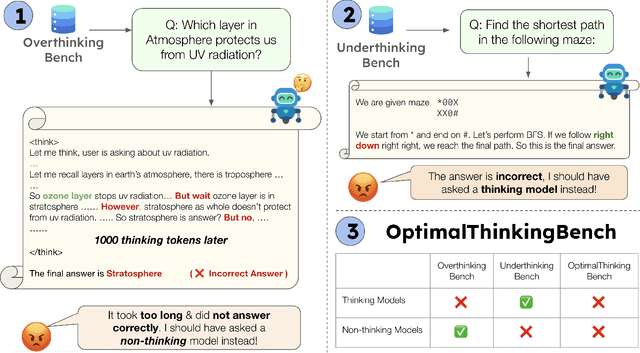
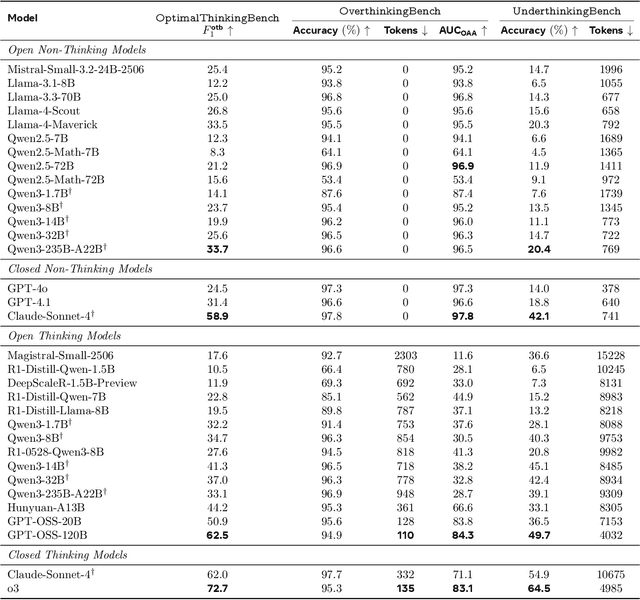

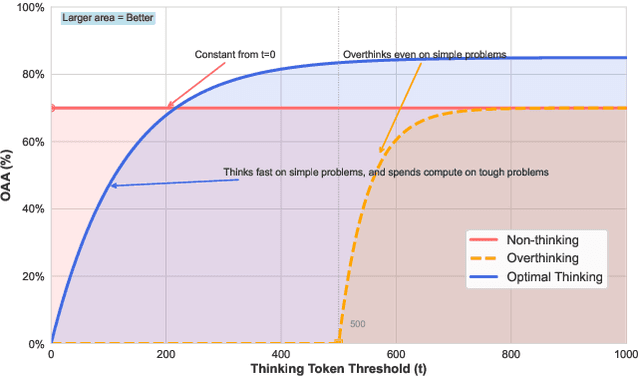
Abstract:Thinking LLMs solve complex tasks at the expense of increased compute and overthinking on simpler problems, while non-thinking LLMs are faster and cheaper but underthink on harder reasoning problems. This has led to the development of separate thinking and non-thinking LLM variants, leaving the onus of selecting the optimal model for each query on the end user. In this work, we introduce OptimalThinkingBench, a unified benchmark that jointly evaluates overthinking and underthinking in LLMs and also encourages the development of optimally-thinking models that balance performance and efficiency. Our benchmark comprises two sub-benchmarks: OverthinkingBench, featuring simple queries in 72 domains, and UnderthinkingBench, containing 11 challenging reasoning tasks. Using novel thinking-adjusted accuracy metrics, we perform extensive evaluation of 33 different thinking and non-thinking models and show that no model is able to optimally think on our benchmark. Thinking models often overthink for hundreds of tokens on the simplest user queries without improving performance. In contrast, large non-thinking models underthink, often falling short of much smaller thinking models. We further explore several methods to encourage optimal thinking, but find that these approaches often improve on one sub-benchmark at the expense of the other, highlighting the need for better unified and optimal models in the future.
Learning to Reason for Factuality
Aug 07, 2025Abstract:Reasoning Large Language Models (R-LLMs) have significantly advanced complex reasoning tasks but often struggle with factuality, generating substantially more hallucinations than their non-reasoning counterparts on long-form factuality benchmarks. However, extending online Reinforcement Learning (RL), a key component in recent R-LLM advancements, to the long-form factuality setting poses several unique challenges due to the lack of reliable verification methods. Previous work has utilized automatic factuality evaluation frameworks such as FActScore to curate preference data in the offline RL setting, yet we find that directly leveraging such methods as the reward in online RL leads to reward hacking in multiple ways, such as producing less detailed or relevant responses. We propose a novel reward function that simultaneously considers the factual precision, response detail level, and answer relevance, and applies online RL to learn high quality factual reasoning. Evaluated on six long-form factuality benchmarks, our factual reasoning model achieves an average reduction of 23.1 percentage points in hallucination rate, a 23% increase in answer detail level, and no degradation in the overall response helpfulness.
CoT-Self-Instruct: Building high-quality synthetic prompts for reasoning and non-reasoning tasks
Jul 31, 2025Abstract:We propose CoT-Self-Instruct, a synthetic data generation method that instructs LLMs to first reason and plan via Chain-of-Thought (CoT) based on the given seed tasks, and then to generate a new synthetic prompt of similar quality and complexity for use in LLM training, followed by filtering for high-quality data with automatic metrics. In verifiable reasoning, our synthetic data significantly outperforms existing training datasets, such as s1k and OpenMathReasoning, across MATH500, AMC23, AIME24 and GPQA-Diamond. For non-verifiable instruction-following tasks, our method surpasses the performance of human or standard self-instruct prompts on both AlpacaEval 2.0 and Arena-Hard.
MetaCLIP 2: A Worldwide Scaling Recipe
Jul 29, 2025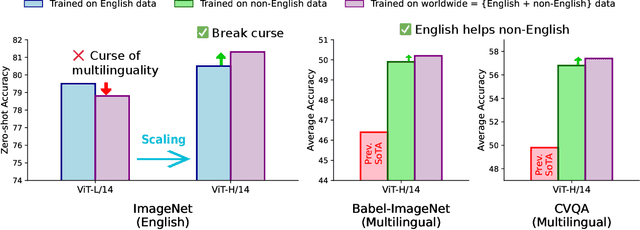

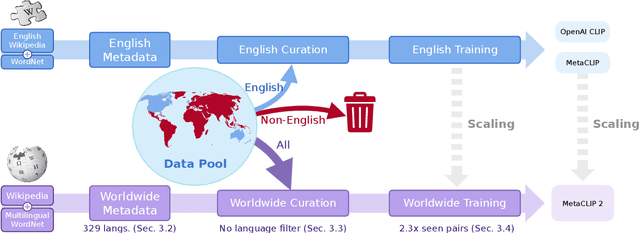

Abstract:Contrastive Language-Image Pretraining (CLIP) is a popular foundation model, supporting from zero-shot classification, retrieval to encoders for multimodal large language models (MLLMs). Although CLIP is successfully trained on billion-scale image-text pairs from the English world, scaling CLIP's training further to learning from the worldwide web data is still challenging: (1) no curation method is available to handle data points from non-English world; (2) the English performance from existing multilingual CLIP is worse than its English-only counterpart, i.e., "curse of multilinguality" that is common in LLMs. Here, we present MetaCLIP 2, the first recipe training CLIP from scratch on worldwide web-scale image-text pairs. To generalize our findings, we conduct rigorous ablations with minimal changes that are necessary to address the above challenges and present a recipe enabling mutual benefits from English and non-English world data. In zero-shot ImageNet classification, MetaCLIP 2 ViT-H/14 surpasses its English-only counterpart by 0.8% and mSigLIP by 0.7%, and surprisingly sets new state-of-the-art without system-level confounding factors (e.g., translation, bespoke architecture changes) on multilingual benchmarks, such as CVQA with 57.4%, Babel-ImageNet with 50.2% and XM3600 with 64.3% on image-to-text retrieval.
NaturalThoughts: Selecting and Distilling Reasoning Traces for General Reasoning Tasks
Jul 02, 2025Abstract:Recent work has shown that distilling reasoning traces from a larger teacher model via supervised finetuning outperforms reinforcement learning with the smaller student model alone (Guo et al. 2025). However, there has not been a systematic study of what kind of reasoning demonstrations from the teacher are most effective in improving the student model's reasoning capabilities. In this work we curate high-quality "NaturalThoughts" by selecting reasoning traces from a strong teacher model based on a large pool of questions from NaturalReasoning (Yuan et al. 2025). We first conduct a systematic analysis of factors that affect distilling reasoning capabilities, in terms of sample efficiency and scalability for general reasoning tasks. We observe that simply scaling up data size with random sampling is a strong baseline with steady performance gains. Further, we find that selecting difficult examples that require more diverse reasoning strategies is more sample-efficient to transfer the teacher model's reasoning skills. Evaluated on both Llama and Qwen models, training with NaturalThoughts outperforms existing reasoning datasets such as OpenThoughts, LIMO, etc. on general STEM reasoning benchmarks including GPQA-Diamond, MMLU-Pro and SuperGPQA.
J1: Incentivizing Thinking in LLM-as-a-Judge via Reinforcement Learning
May 15, 2025Abstract:The progress of AI is bottlenecked by the quality of evaluation, and powerful LLM-as-a-Judge models have proved to be a core solution. Improved judgment ability is enabled by stronger chain-of-thought reasoning, motivating the need to find the best recipes for training such models to think. In this work we introduce J1, a reinforcement learning approach to training such models. Our method converts both verifiable and non-verifiable prompts to judgment tasks with verifiable rewards that incentivize thinking and mitigate judgment bias. In particular, our approach outperforms all other existing 8B or 70B models when trained at those sizes, including models distilled from DeepSeek-R1. J1 also outperforms o1-mini, and even R1 on some benchmarks, despite training a smaller model. We provide analysis and ablations comparing Pairwise-J1 vs Pointwise-J1 models, offline vs online training recipes, reward strategies, seed prompts, and variations in thought length and content. We find that our models make better judgments by learning to outline evaluation criteria, comparing against self-generated reference answers, and re-evaluating the correctness of model responses.
Multi-Token Attention
Apr 01, 2025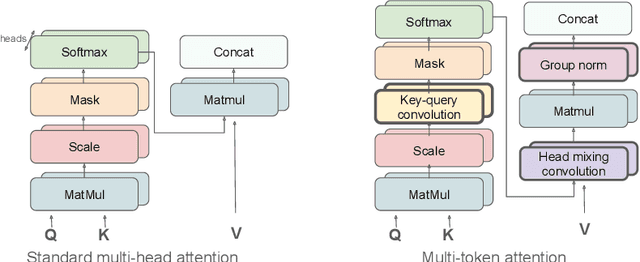


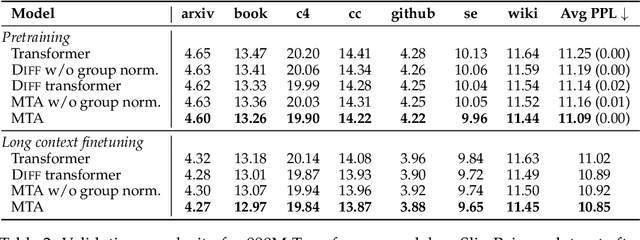
Abstract:Soft attention is a critical mechanism powering LLMs to locate relevant parts within a given context. However, individual attention weights are determined by the similarity of only a single query and key token vector. This "single token attention" bottlenecks the amount of information used in distinguishing a relevant part from the rest of the context. To address this issue, we propose a new attention method, Multi-Token Attention (MTA), which allows LLMs to condition their attention weights on multiple query and key vectors simultaneously. This is achieved by applying convolution operations over queries, keys and heads, allowing nearby queries and keys to affect each other's attention weights for more precise attention. As a result, our method can locate relevant context using richer, more nuanced information that can exceed a single vector's capacity. Through extensive evaluations, we demonstrate that MTA achieves enhanced performance on a range of popular benchmarks. Notably, it outperforms Transformer baseline models on standard language modeling tasks, and on tasks that require searching for information within long contexts, where our method's ability to leverage richer information proves particularly beneficial.
 Add to Chrome
Add to Chrome Add to Firefox
Add to Firefox Add to Edge
Add to Edge